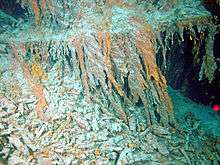Halomonas titanicae
Halomonas titanicae is a gram-negative, halophilic species of proteobacteria which was discovered on rusticles recovered from the wreck of the RMS Titanic. Cristina Sánchez-Porro et al. first isolated the bacterium in 2010 from a sample of rusticle obtained from the RMS Titanic in 1991.[1] One of the researchers, Henrietta Mann has estimated that the action of microbes like Halomonas titanicae may bring about the total deterioration of the Titanic by 2030. While the bacteria have been identified as a potential danger to oil rigs and other man-made objects in the deep sea, it also has the potential to be used in bioremediation to accelerate the decomposition of shipwrecks littering the ocean floor.[2][3]
| Halomonas titanicae | |
|---|---|
 | |
| Scientific classification | |
| Kingdom: | |
| Phylum: | |
| Class: | |
| Order: | |
| Family: | |
| Genus: | |
| Species: | H. titanicae |
| Binomial name | |
| Halomonas titanicae Mann, Kaur, Sánchez-Porro & Ventosa 2010[1] | |
In summer 2016, using neutron diffraction, the facilities of the Institut Laue-Langevin demonstrate that a molecule called ectoine is used by these bacteria to survive the osmotic pressure that salt water causes on their membranes.[4]
References
- Cristina Sánchez-Porro; Bhavleen Kaur; Henrietta Mann; Antonio Ventosa (2010). "Halomonas titanicae sp. nov., a halophilic bacterium isolated from the RMS Titanic" (PDF). International Journal of Systematic and Evolutionary Microbiology. 60: 2768–2774. doi:10.1099/ijs.0.020628-0. PMID 20061494.
- Betsy Mason (May 24, 2011). "Top 10 New Species Discovered in 2010". Wired. Retrieved June 7, 2011.
- "New species of bacteria found in Titanic 'rusticles'". BBC News. December 6, 2010. Retrieved June 7, 2011.
- laboratoryequipment.com, September 6, 2016, Extremophile Bacteria’ Will Eat Away Wreck of the Titanic by 2030.